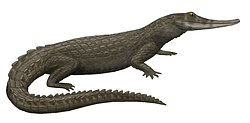Top Qs
Timeline
Chat
Perspective
Winton Formation
Geological formation in Queensland, Australia From Wikipedia, the free encyclopedia
Remove ads
The Winton Formation is a Cretaceous geological formation in central-western Queensland, Australia. It is late Albian to early Turonian in age.[2] The formation blankets large areas of central-western Queensland. It consists of sedimentary rocks such as sandstone, siltstone and claystone. The sediments that make up these rocks represent the remnants of the river plains that filled the basin left by the Eromanga Sea - an inland sea that covered large parts of Queensland and central Australia at least four times during the Early Cretaceous period. Great meandering rivers, forest pools and swamps, creeks, lakes and coastal estuaries all left behind different types of sediment.
In some areas, the Winton Formation is over 400 metres thick. To bring with them such a huge amount of sediment, the rivers that flowed across these plains must have been comparable in size to the present-day Amazon or Mississippi rivers. As more and more sediment was brought in, the margins of the inland sea slowly contracted. By around 95 million years ago, the deposition was complete and the inland sea would never be seen again.
By virtue of its age and the environmental conditions under which the rocks it consists of were deposited, the Winton Formation represents one of the richest sources of dinosaur fossils anywhere in Australia.
Remove ads
Fauna
Summarize
Perspective
A fossil footprint-(ichnite), Wintonopus, found with two other dinosaur genera footprints at the Lark Quarry in Australia, c.f. Tyrannosauropus and Skartopus, have been found in the Winton Formation.
Mollusca
Arthropods
Chondrichthyes
Dipnoi
Actinopterygii
Squamates
Chelidae
Sauropterygia
Crocodyliformes
Dinosaurs
Ornithischians
Sauropods
Theropods
Pterosaurs
Therapsida
Remove ads
Flora
Remove ads
See also
- Lark Quarry Conservation Park
- Australian Age of Dinosaurs, which operates the Australian Age of Dinosaurs Museum of Natural History, and holds annual dinosaur digs in the Winton Formation
- List of dinosaur-bearing rock formations
- South Polar region of the Cretaceous
References
Wikiwand - on
Seamless Wikipedia browsing. On steroids.
Remove ads












